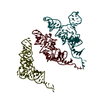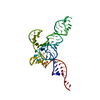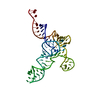+Search query
-Structure paper
| Title | Uncovering translation roadblocks during the development of a synthetic tRNA. |
|---|---|
| Journal, issue, pages | Nucleic Acids Res, Vol. 50, Issue 18, Page 10201-10211, Year 2022 |
| Publish date | Oct 14, 2022 |
 Authors Authors | Arjun Prabhakar / Natalie Krahn / Jingji Zhang / Oscar Vargas-Rodriguez / Miri Krupkin / Ziao Fu / Francisco J Acosta-Reyes / Xueliang Ge / Junhong Choi / Ana Crnković / Måns Ehrenberg / Elisabetta Viani Puglisi / Dieter Söll / Joseph Puglisi /   |
| PubMed Abstract | Ribosomes are remarkable in their malleability to accept diverse aminoacyl-tRNA substrates from both the same organism and other organisms or domains of life. This is a critical feature of the ...Ribosomes are remarkable in their malleability to accept diverse aminoacyl-tRNA substrates from both the same organism and other organisms or domains of life. This is a critical feature of the ribosome that allows the use of orthogonal translation systems for genetic code expansion. Optimization of these orthogonal translation systems generally involves focusing on the compatibility of the tRNA, aminoacyl-tRNA synthetase, and a non-canonical amino acid with each other. As we expand the diversity of tRNAs used to include non-canonical structures, the question arises as to the tRNA suitability on the ribosome. Specifically, we investigated the ribosomal translation of allo-tRNAUTu1, a uniquely shaped (9/3) tRNA exploited for site-specific selenocysteine insertion, using single-molecule fluorescence. With this technique we identified ribosomal disassembly occurring from translocation of allo-tRNAUTu1 from the A to the P site. Using cryo-EM to capture the tRNA on the ribosome, we pinpointed a distinct tertiary interaction preventing fluid translocation. Through a single nucleotide mutation, we disrupted this tertiary interaction and relieved the translation roadblock. With the continued diversification of genetic code expansion, our work highlights a targeted approach to optimize translation by distinct tRNAs as they move through the ribosome. |
 External links External links |  Nucleic Acids Res / Nucleic Acids Res /  PubMed:35882385 / PubMed:35882385 /  PubMed Central PubMed Central |
| Methods | EM (single particle) |
| Resolution | 2.6 - 3.0 Å |
| Structure data | EMDB-26705, PDB-7ur5: EMDB-26713, PDB-7uri: EMDB-26714, PDB-7urm: |
| Source |
|
 Keywords Keywords |  RNA / RNA /  tRNA / tRNA /  selenocysteine / selenocysteine /  ribosome ribosome |
 Movie
Movie Controller
Controller Structure viewers
Structure viewers About Yorodumi Papers
About Yorodumi Papers










